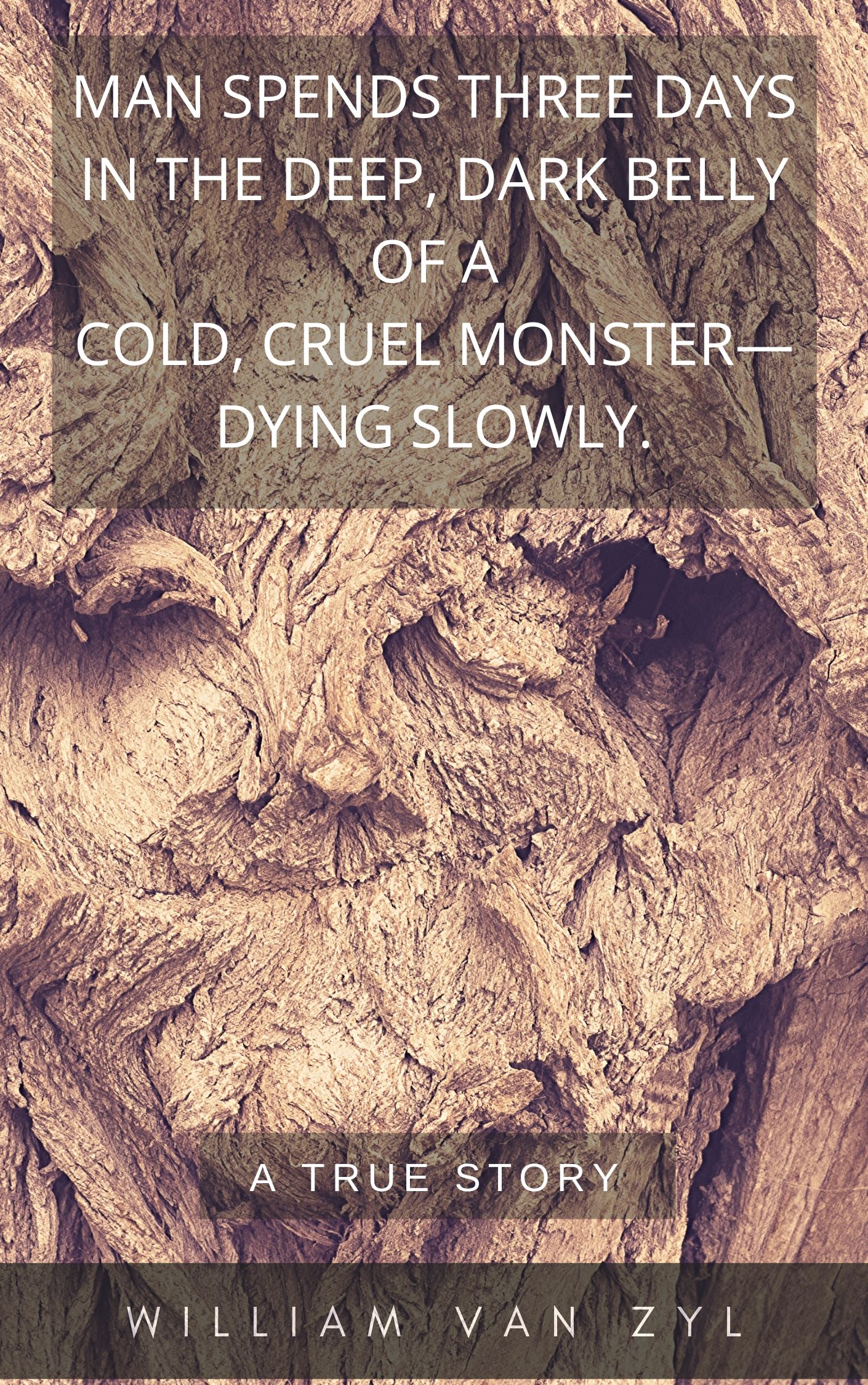
Listen to the podcast: https://www.podbean.com/ew/pb-4tisi-1020ac2

Table of Contents
Encountering the monster
Copyright©William Van Zyl – April 2020
Harrison – not Harrison Ford – is trapped. It is day three.
Off the East coast of Africa, in a remote part of the ocean, 32 km from land, the Nigerian man is praying.
“God, I am done praying. I am giving it over to You. Let it be as it is in Heaven. You have never failed me in the past, I know You will not fail me now.”
After hours and hours of prayer, this is his last prayer – he stops – he is at peace.
It is dark – pitch dark – it has been for days. The only sound he can hear is his shallow breathing. It is getting shallower by the hour.
Then, there is a nibble, “what could that be?” he holds his breath. He listens.
It is so dark that his imagination struggles to penetrate the thick depressing lack of light. However, he ‘sees’ his wife and family. He shivers. It is freezing cold. Then a shiver runs down his spine – he thinks about his dire situation. It is a desperate thought that turns the shiver into shaking.
“ I have to keep calm and breathe slowly. I must conserve energy and oxygen,” he mumbles to himself. Then he forces himself to relax.
He has visited his family, and his wife – in his mind. He has given them his last thoughts. He has said his goodbyes – reluctant though. He wants to live, not die at this unholy depth. His soul is compressed.
A large, cold, cruel, monster-fish has swallowed Harrison.
It happened suddenly, without any warning. It showed no mercy. The sudden blast of the cold liquid and the churning of the tummy of the monster-fish is all he can remember. He is in the tummy of the death-monster – cold, wet and dark. There have been vague stomach gurgling for some time further down the belly. However, the tummy of the cruel monster has stopped rumbling. It is quiet now. Dead quiet.
Hours passed.
“There it is again; it sounds like something scraping against the tummy lining. Yes, I am sure it sounds like scraping.” Harrison sits up. He presses his ear against the cold tummy of the monster.
“It is definitely a vibration of some sort,” he thinks.
He hears air bubbles. Could it be gas escaping? He hears a muffled voice.
‘ Am I hallucinating, I am busy dying?´ he thinks. He closes his eyes. “Bang, bang, bang.”
Something is banging.
Harrison grabs anything he can find. He signals back.
“Bang, bang, bang.” Then it is quiet.
Then from nowhere, a dim beam of light lights up the water around his feet. He sees the outline of his cold, bare feet below him.
“Am I in heaven?” he is overwhelmed. He feels his pulse with his thumb. His heart is still beating. “Thank God!” he mumbles.
“I am still alive; my heart is still beating,” he assures himself.
The light gets brighter.
“What! Is this the angel of death?” Then a second thought raced through his mind. Could it be people looking for him? It is impossible. ’How can people get into the tummy of a large monster-fish?’
A black monster-frog-figure suddenly pops up in front of him. “Have the cruel-fish swallowed another victim?” He can’t see properly; the sudden light is overwhelming.
The black frog’s head pops out of the water. Their eyes meet. They are both stunned.
The black frog lifts his long flipper foot out of the water. Harrison carefully touches it.
Then the frog speaks through a monstrosity around his mouth.
“What-is-your-name? “ Harison is shocked. He covers his throat with his hand.
“My name is Harrison,” he answered in a shaky voice.
The rescue diver can’t believe his eyes. They were commissioned to retrieve bodies, not survivors!
“He is alive, he is alive!” a second voice talks back to the frog. “Keep him calm, reassure him, keep him calm.”
“Who are you?”
“I am Harrison, Harrison, the cook.”
The diver then talked to his dive buddy via the mask-communication-system.
“ I nearly had a heart attack; you won’t believe what I have found?”
“What, a survivor, where?”
“Yes, you won’t’ believe it. I have found Harrison, the cook, in the belly of the boat.”
“ What, are you serious? Yes, now I can see him. It is unbelievable. Assure him, assure him we will get him out. I will contact the captain and the rescue team to brainstorm how we are going to get him out of the belly.”
“Be careful with your supply line. Be very careful now.”
“I will be cautious,” said the diver to his dive buddy. The three men are connected via an umbilical cord. They communicate freely. The rescue diver, his dive buddy outside the wreck, and the person on the surface in the large boat are talking. The monitor on the boat shows everything via the headcam. They can hear everything. A camera is mounted on the head of the rescue diver, Nico Van Heerden – a South African – it is recording everything as it unfolds.
“How long have you been here?”
“I don’t know?”
After a couple of minutes, his dive buddy explained the plan to the diver at the front with Harrison. Then the diver carefully instructed Harrison. An adrenaline rush widened Harrison’s eyes – he can’t believe what is happening.
“Harrison, you will have to wait here. I will come back and take you to the bell. From there we will get you out. We are going to get you home,” the diver assured him.
Nico touched his hand.
Harrison nodded. He was calm and collected.
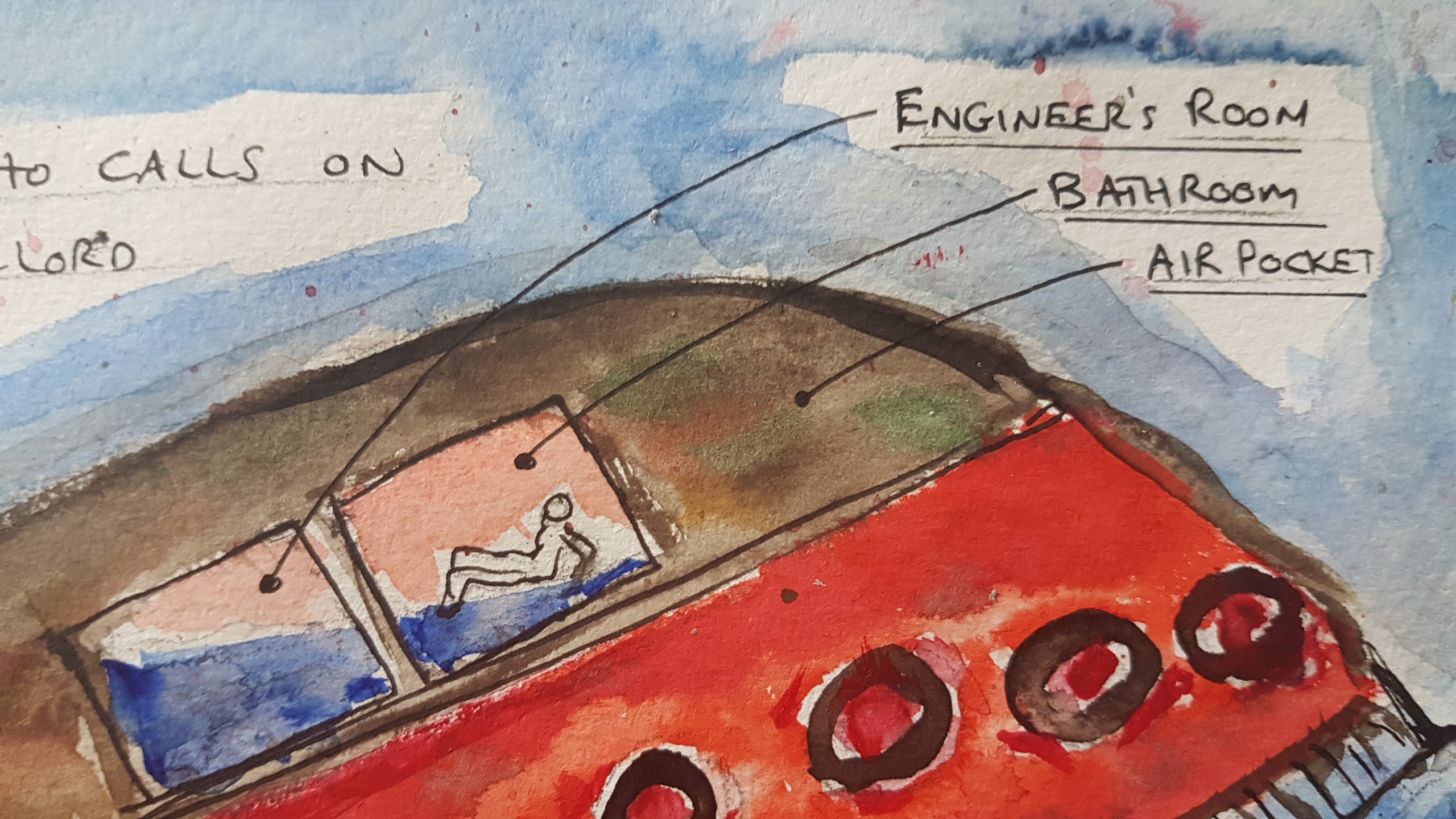
After a further couple of minutes, the diver returned with a headpiece connected to an air supply line – the umbilical – which stretched from the diving bell. It was the lifeline that would supply Harrison with life – the ‘cord of life.’
The diving bell – a large bell-shaped structure filled with oxygen, used as a base station underwater, with all types of support equipment for the divers to perform their tasks – floated at about 30 metres below the surface next to the wreck. The bell was situated slightly above the sunken boat.
“Harrison, this is a headpiece. I am going to push it over your head and strap it to your head. Ok?”
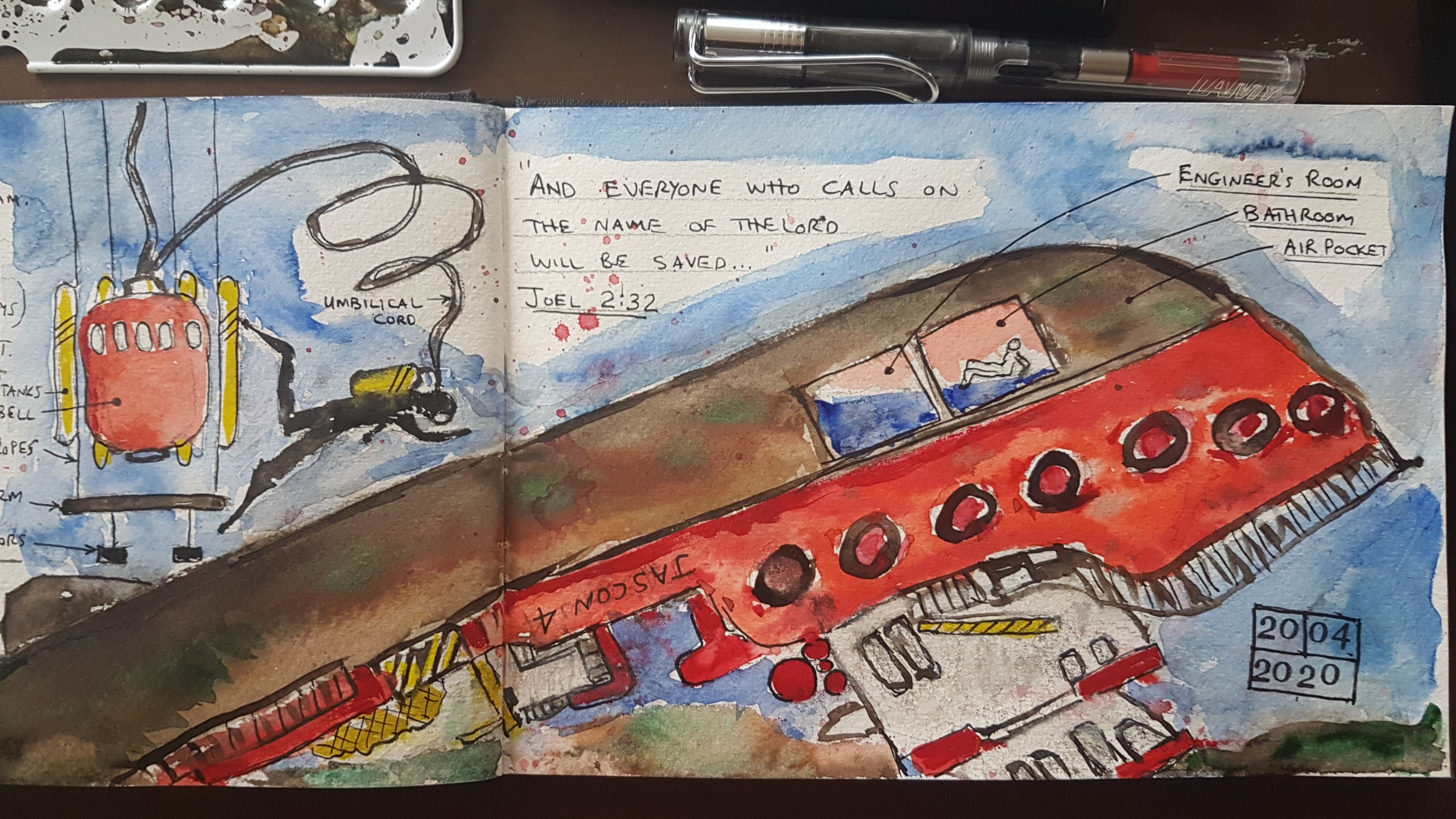
“Yes, yes!” Harrison nodded and slipped from the small floating platform he had been sitting on into the water next to the diver. Harrison was calm and focused.
The diver carefully pushed the headpiece over Harrison’s face and head. He strapped the life-giving diving equipment to his head.
“Can you breathe, can you hear me. Harrison?” Harrison could now hear the voice of the diver clearly via the speaker and microphone in the headset. He also listened to the other men speaking on the system as they take turns to talk.
“Yes, I can, yes I can.”
“Now come with me, be careful with the supply line. Everything is going to be fine. We are going to get you home.” The rescue-diver chuckled.
As Harrison came out of the dark wreck into the mottled light, he passed out. The diver who monitored him closely shouted to his buddy, “Quickly he has passed out, pull him up into the bell!”
The dive buddy at the bell started hauling Harrison up by pulling him up with the supply line. It was a considerable risk, but he had no choice. ‘Save him he thought, we can’t lose him now!’
In the diving bell, Harrison regained his consciousness. The relief must have overwhelmed him.
“Harrison, are you ok?”
“Yes, I am fine,” he responded.
They warmed Harrison with a flow of warm water from the rescue boat. His cold shivering body welcomed the warm, soothing water circulating around his body. The hypothermia slowly lifted.
In a couple of stages – decompressing as they went up – Harrison arrived safely at the rescue boat on the surface.
When Harrison saw the daylight, he smiled from ear to ear. God has sent the divers to save him. After several hours in the decompression chamber, Harrison was safe. Harrison did not get the ‘bends.’ The whole process took several hours. The rescue effort started in the morning – it was now late afternoon.
This extraordinary true story of survival and rescue has gripped my attention and sent my imagination running wild. In April 2020, during the COVID-19 lockdown, I watched the documentary on the National Geographic channel with the title ‘Rescued.’ For days, I pondered the desperate situation Harrison found himself in on that day. There are so many unique aspects to the story. I have done some research, and I will share it with you. But first, the facts. The rescue was successfully executed in 2013.
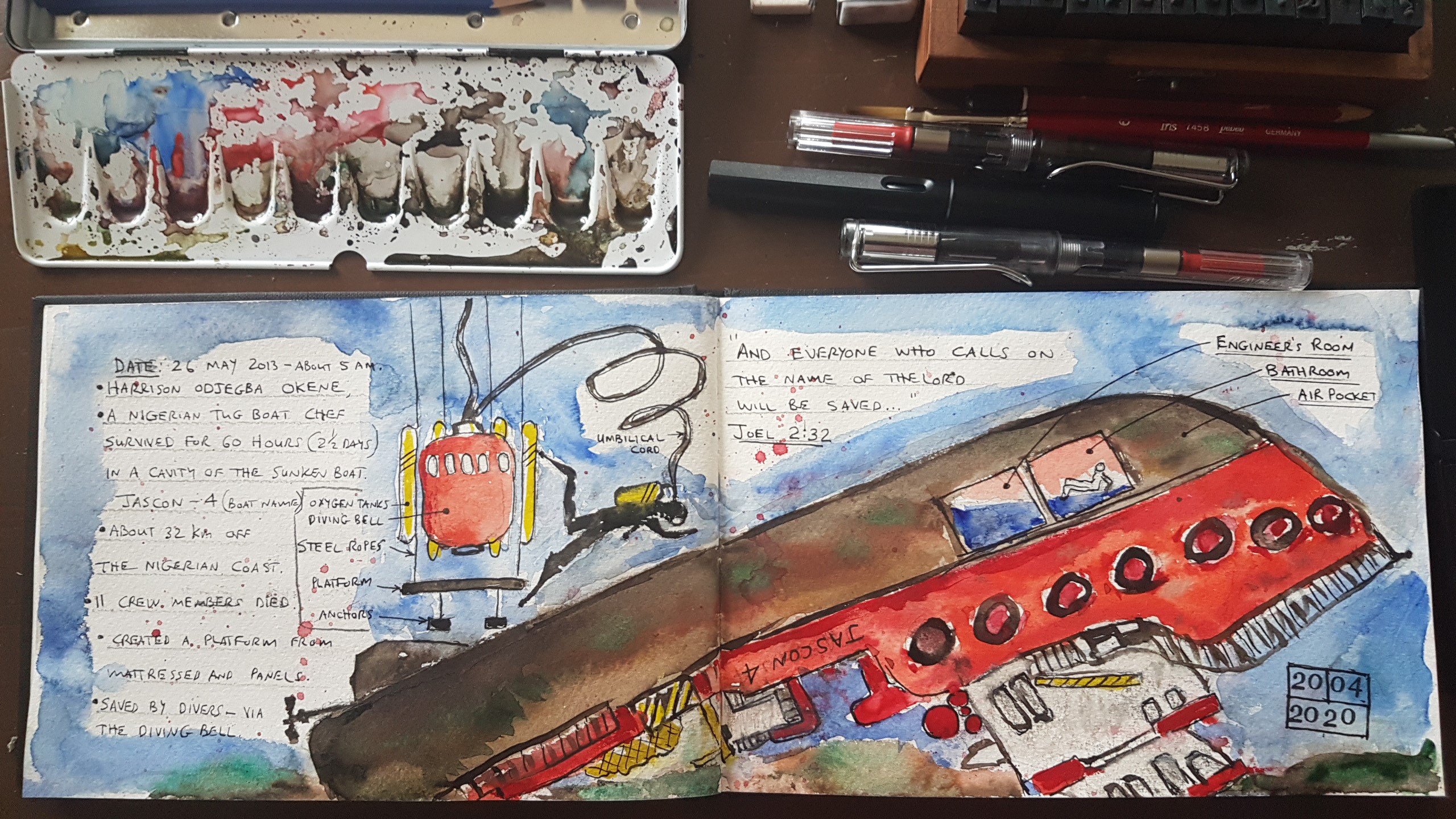
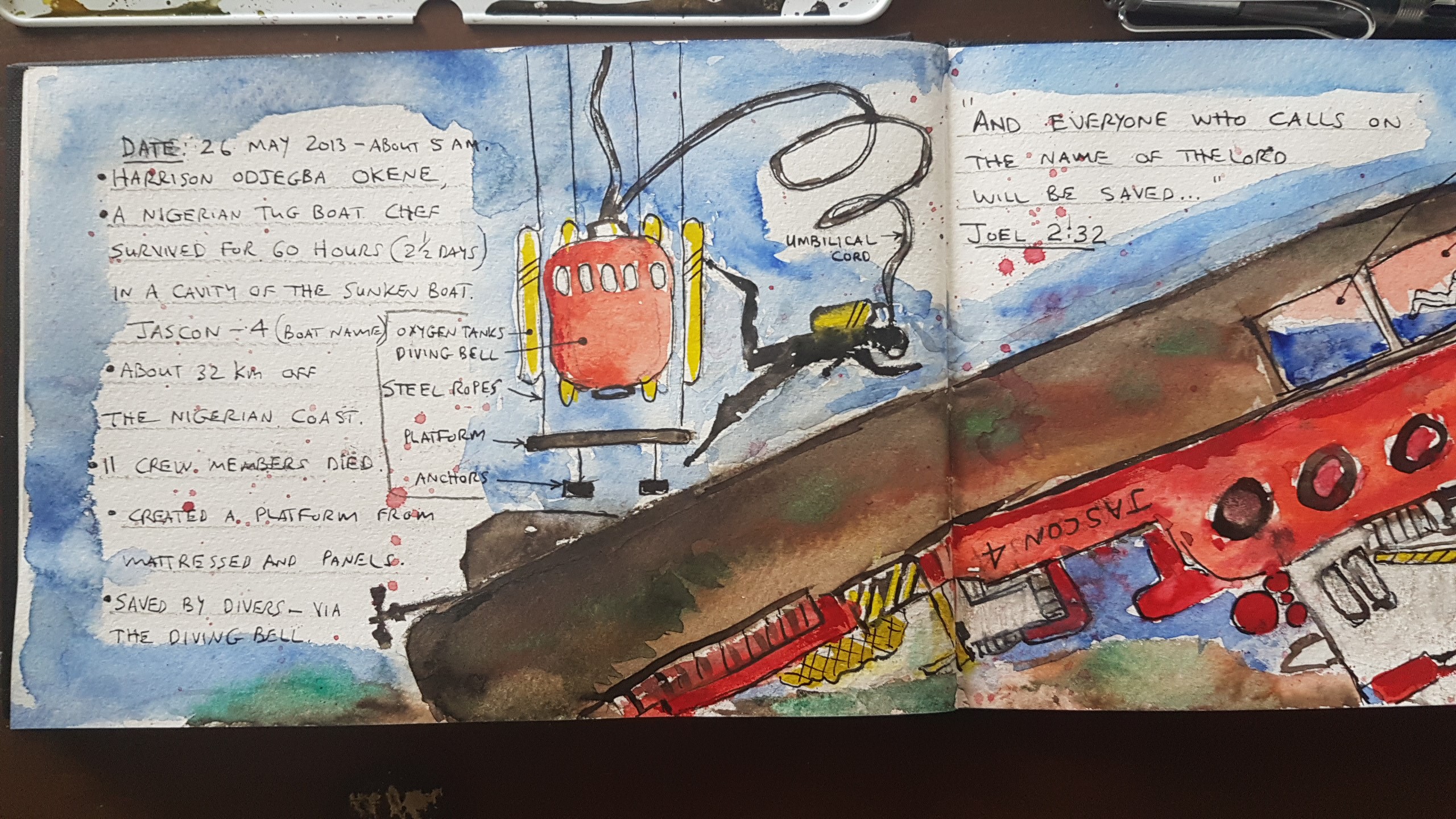
A radio crackles in Nigeria. Monica Mark, a reporter from Lagos in Nigeria, reports:
A Nigerian sailor who survived for almost three days underwater by crouching in an air bubble after his tugboat capsized has spoken about his ordeal.
Harrison Okene, a 29-year-old cook, was the sole survivor of the Jascon-4, which overturned after being battered by heavy swells last month. Eleven other crew members died as the vessel sank some 12 miles (20 km) off Nigeria’s mangrove-lined coast.
“It was around 5 am, and I was on the toilet when the vessel just started going down – the speed was so, so fast,” Okene said by phone from his hometown of Warri. Scrambling out, he was unable to reach an emergency exit hatch and watched in horror as three crew members were sucked into the churning sea.
The water swept him into another toilet as the boat plunged 30 metres into the freezing depths. Wearing only his underpants, Okene prayed as water seeped slowly but steadily into a 4-ft sq air bubble in the cabin (a 1.2-metre high cavity).
“All around me was just black and noisy. I was crying and calling on Jesus to rescue me, and I prayed so hard. I was so hungry and thirsty and cold, and I was just praying to see some kind of light.”
He had been underwater for almost 60 hours when he heard a hammering on the deck. A team of South African divers scouring the waters on a presumed body recovery operation were shocked to hear faint hammering in reply.
Credit: Monica Mark in Lagos, Wed 12 Jun 2013.
Link to the article https://www.theguardian.com/world/2013/jun/12/nigeria-sailor-survive-air-pocket
There are so many things that went through my mind as I watched and researched this amazing story. Here is the takeaway.
Footage of the rescue of Harrison Okene.https://www.youtube.com/embed/BtE6ZyHis8k?version=3&rel=1&showsearch=0&showinfo=1&iv_load_policy=1&fs=1&hl=en&autohide=2&wmode=transparent
Footage of the rescue of Harrison Okene. He was rescued from a wreck in 2013—by South African divers—after being trapped for three days in 30-meter deep water. https://youtu.be/BtE6ZyHis8k
A scientific look at the whole drama.
Look closely at the ‘Diagram showing the divisions of the world’s oceans,’ below. Note that the tugboat sunk to a depth of only 30 meters. Right at the top of the diagram, left-hand corner is a red star indicating the location of the Jascon-4.
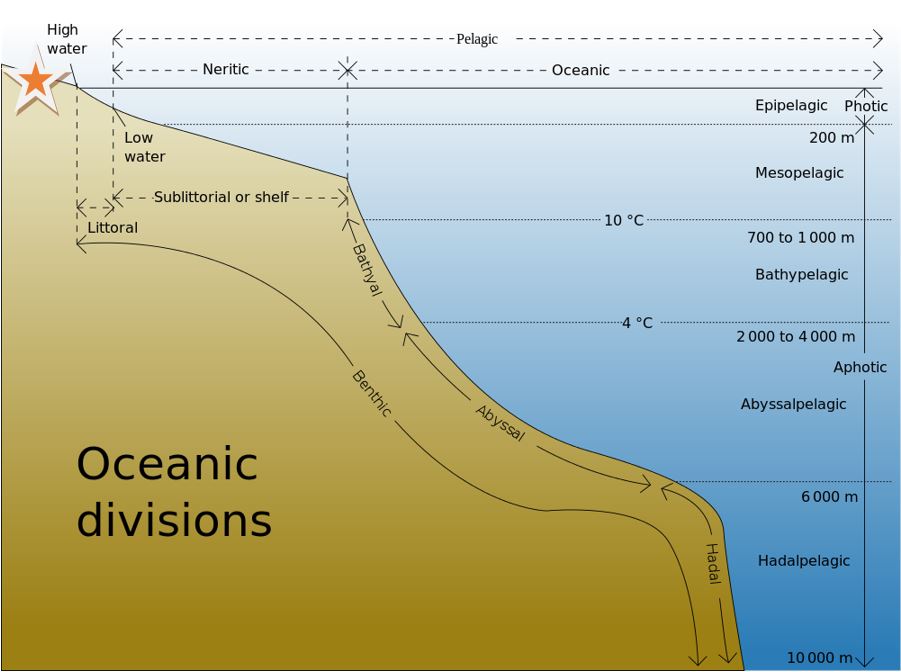
David Latchman – in his great scientific article compares the Okene survival with a dive-bell-spider – Okene’s situation is different from the spider’s bubble. The dive-bell-spider weaves a particular net and traps oxygen bubbles in it’s web and then takes it under the water – just like a diver with its scuba gear. The spider uses the oxygen to survive under the water for long periods. Here is an excerpt of Latchman’s article comparing Okene’s survival with the dive-bell-spider:
‘Unlike the bubble interface of the diving bell spider, which is curved, the surface of Okene’s “bubble” is flat. This means the air pressure inside the bubble is the same as the water (hydrostatic) pressure. At a depth of 30 meters, this is close to four atmospheres, or four times the pressure you are currently experiencing now. Does this mean that equal pressures between the bubble interface imply no gas transfer? Not quite. As you probably guessed, there is a bit more science to the story.
When the tugboat sank to a depth of 30 meters, it ended up lying close to the oxygen-minimum area of the pelagic zone — not near the surface, nor near the bottom. Seymour tells us that, ‘Oxygen enters the ocean from the surface and is produced by phytoplankton in the photic zone (the zone where there is sufficient sunlight for photosynthesis to occur). The debris from this zone falls through the water and is consumed by microorganisms below the photic zone. This consumes the oxygen from the water, creating the oxygen minimum zone that is very low in oxygen from about 50 meters to about 200 meters.‘
CREDIT: Article by David Latchman – Freelance science writer and blogger with a background in physics and mathematics (31 December 2013).
Link to the scientific article: https://medium.com/@SciWriterDave/did-ficks-law-save-harrison-odjegba-okene-f34d66fd7f37https://www.youtube.com/embed/1rlt9yAhqTw?version=3&rel=1&showsearch=0&showinfo=1&iv_load_policy=1&fs=1&hl=en&autohide=2&wmode=transparent
The Dive-Bell-Spider.
Resource:
Because the bathroom and engineer’s cabin were located 30 m below the surface, the pressure was high. In fact, four times higher what we breathe under normal circumstances. That meant that oxygen in the cabin had been compressed, giving Okene enough to last him for around 60 hours. By splashing around – getting mattresses and panels form the engineer’s chamber – the cook unwittingly increased the surface area of the water around him, thus making it easier for carbon dioxide to be absorbed. A very courageous act to dive in the dark from the bathroom to the engineer’s chamber to get something to sit on. He did this to sit above the cold water to eliminate dying from hypothermia. Okene managed to fight off hypothermia by keeping himself above the water level with the makeshift floating platform. But, despite his relative good fortune, the brave survivor was running out of time. After spending two-and-a-half days, submerged, Okene recognized the distant sound of a boat’s engine. And, when he heard an anchor drop and paddling divers, he knew that a rescue mission was underway. Unfortunately, it wasn’t guaranteed to succeed. How would the rescuers know which part of the boat Okene was in? There was only thing Okene could do and that was to make himself visible. The cook decided to dive into the painfully cold water to make himself visible. Once he was submerged, he swam towards the torchlight.
Diver Nico van Heerden must have had the fright of his life when Okene’s hand reached out from the gloom towards him. He initially assumed it belonged to a corpse, but then he realized that this man was very much alive.
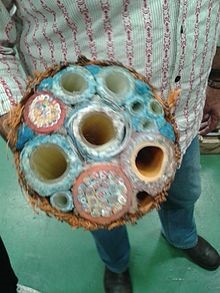
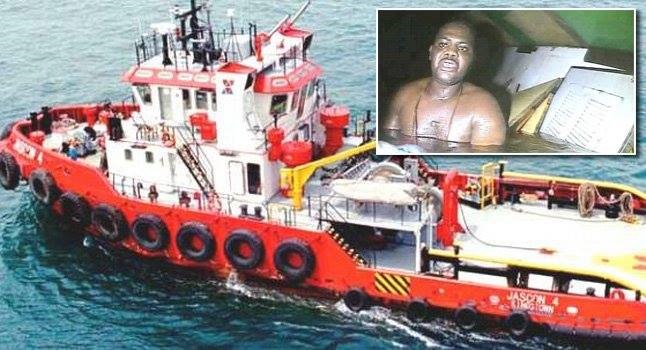
Full summary, with facts, about the rescue in detail: ‘I was trapped underwater for three days.’
FROM HARRISON’S FACEBOOK PAGE: Posted 26 May 2019
‘Today is May 26th 2019 and it makes my survival story in West African Ventures Company (Jascon 4) six years old today, I thank the Lord God Almighty for me been alive till this day after the prediction that I will not be alive after six months or normal in life but is still there for me. I will never live to forget this day and the grace of the Lord in my life and my fellow sailing seafarer brothers that lost their life and I pray for them to fine peace in the hand of the Lord until we meet again and pat no more and my God bless their family greatly.’ Names of all crews in Jascon 4 tugboat that lost their life in May 26 th 2013. Captain. Loveday Karibo, Chief engineer. From Ukraine. Chief Mate. Johnny Ohwonam, Second engineer. Odida Martins. Third engineer. Bassy Idolor. Bosun. Richard Egbe. Able seaman. Michael Egdedi, Able seaman. Richard Kuyoma. Able seaman. Oneybeze. Able seaman. Peter Akere. Cadet. Lucky Ola.
— feeling hopeful.
Harrison Okene.
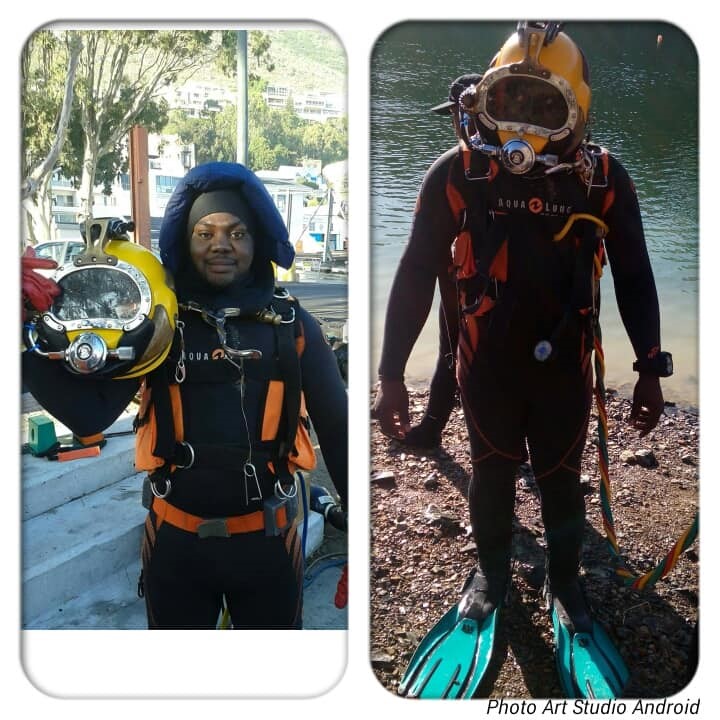
The rescue team (quick fact):
The names of the three South African divers involved in the rescue: André Erasmus 42, from Durban, Nico van Heerden, 32, and Darryl Oosthuizen, 47, both from Cape Town.
Jonah three days in the belly of the fish
Let’s consider the well-known story of Jonah and the big fish. The chemistry of the tummy of the large fish could have harmed Jonah.
*Don’t miss the 5 important things Jonah did – find it at the end of this article
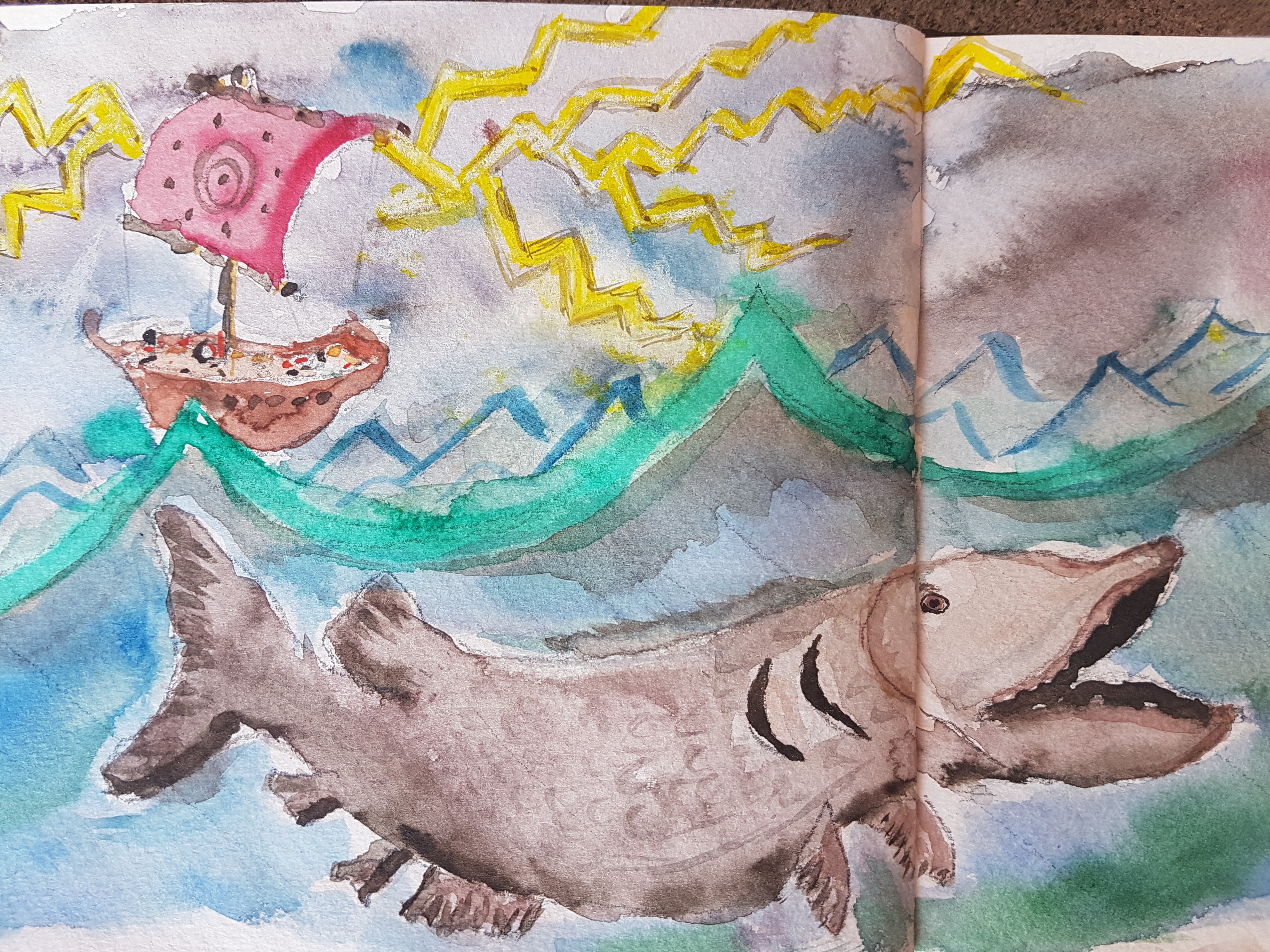
Scientifically, carnivorous fish has digestive enzymes in their stomachs that works in the digestion of protein. Jonah’s body was made up of protein. From a scientific perspective, the fish that swallowed him was not a carnivorous fish but a vegetarian. It had seaweeds, plants, and greenery in its belly. Its digestive system comprised of plant-eating-enzymes; biologically these enzymes are different for predatory fish. Therefore, what happened to Jonah is scientifically possible. Of course, it was a miracle.
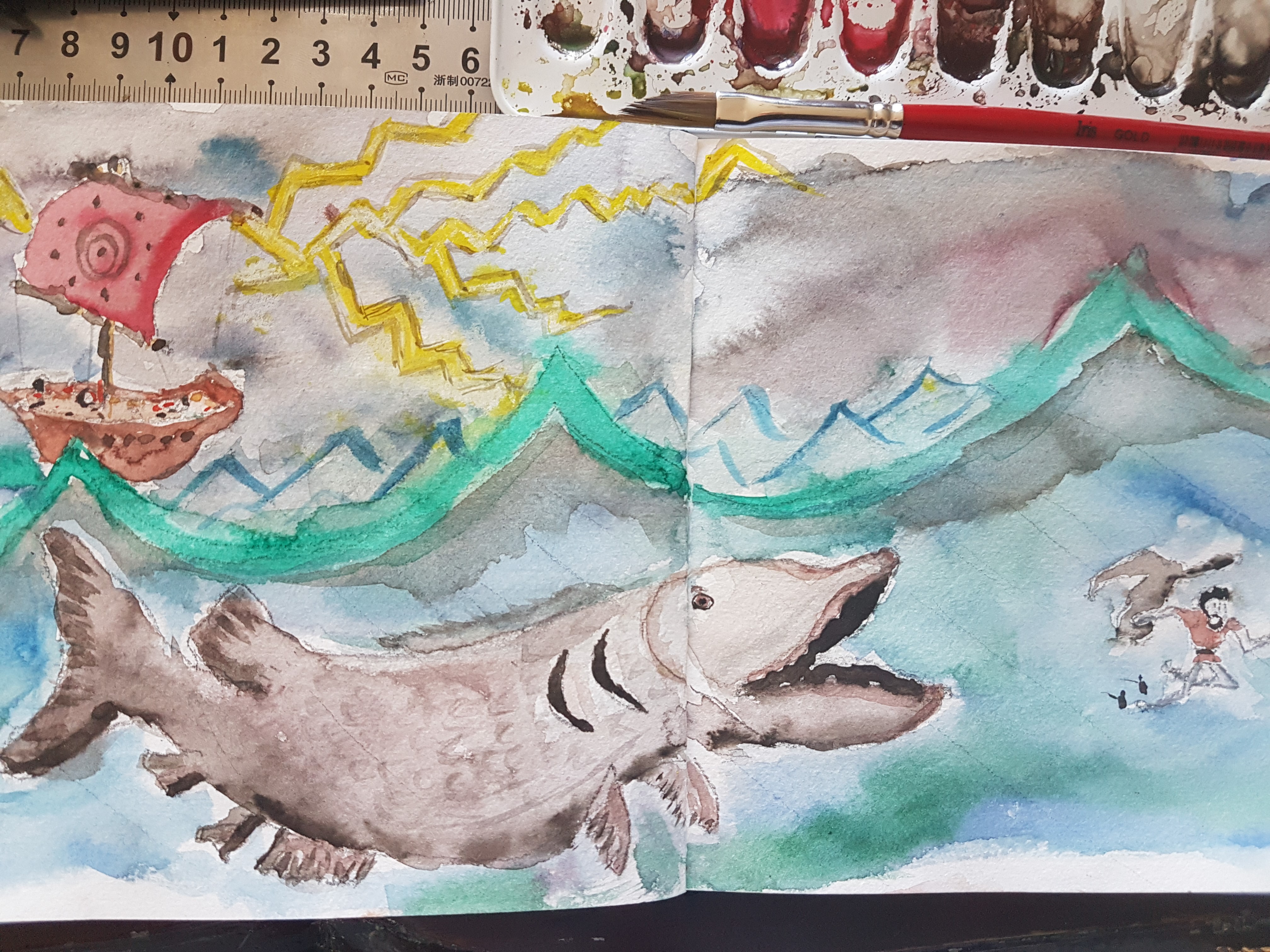
Three days is a long time in the belly of a fish
Okene was three days in the ‘cold belly of the fish’, Jonah was three days in the belly of the fish, and Jesus was three days in the belly of the earth.
Have you ever been in the dark ‘belly’ of a season of adversity, tragedy, distress, depression, or despair?
It seems like these seasons could be 3 hours, 3 days, 3 weeks, or 3 months – even as long as 3 years. Sometimes even longer. I have been in the belly of such a beast for three long years. It is a lonely place; a solitary place. In hindsight, it is the time in which I have developed and overcame the most. I call it my Fictilis Arte season; a season of financial loss – destruction. A watershed moment. A shalshelet. But, what is a shalshelet? A shalshelet is a musical note found in the Torah. It appears only 4 times – in Genesis 19:16, 24:12, and 39:8, and Leviticus 8:23. It is the squiggly line shown below – it looks like ‘lightning.’ It indicates a moment of hesitation – a decision has to be made that would have a very significant influence in one’s life in future. Can you identify such a moment or moments in your life? I have about three up to date. They were crucial stages in my personal life. Now, reflect and identify your own watershed moments. Jot them down – what had been the impact of your decision?
THE SHALSHELET
‘Words have the power to express ideas. But, as expressive as words can be, they can sometimes be limiting. Often music can give soul and meaning to ideas that words cannot.
This concept is also true with respect to the melody (trop) used to read the Torah. The tune actually acts as a commentary on the text itself.
The highest and most prolonged trop is called the shalshelet. The word shalshelet is from the word shalosh – three. The sound of this note curves upward and then down three successive times. Commentators suggest that when a shalshelet appears, it indicates a feeling of hesitation by a character in the text.
For example, when Mrs. Potiphar attempts to seduce Yosef (Joseph), Yosef refuses, va-yemaen (Genesis 39:8). Although saying no, Yosef, at first, may have thought about giving into temptation. The word va-yemaen has, as its trop, the shalshelet.’
Imagine what would have happened if Joseph gave in to temptation? His destiny would have been destroyed!
Credit: Excerpt – The shalshelet: the musical note with a deep message. https://library.yctorah.org/2016/05/the-shalshelet-the-musical-note-with-a-deep-message/
I have been through a shalshelet season more than 25 years ago. Have you been through such a season? Or, maybe you are in such a season? I think every person’s shalshelet moments or seasons are different. Thank goodness, I have recovered from that season of devastation. I made the right choices. I have done the 5 things Joseph did. But, how do one survive such a season or time, and what is the relevance of the shalshelet to this article? Here is the take away:
#1 – If you are in distress – call upon a Higher Authority – someone outside yourself.
What was Okene’s first action when he was swallowed? When he was floating in the belly of the cold dark ‘fish.’ Okene’s shalshelet moment, Jonah’s shalshelet moment, and my shalshelet moment required a decision. A watershed decision. Jonah immediately started to pray. Very smart indeed – prayer changes us. Okene called upon the Name of the Lord for help. I called on His Name. Jonah did the same when he was in distress in the belly of the fish. He prayed:
2 …“In my distress, I called to the Lord,
and He answered me.
From deep in the realm of the dead I called for help,
and You listened to my cry.
3 You hurled me into the depths,
into the very heart of the seas,
and the currents swirled about me;
all your waves and breakers
swept over me.” Jonah 2: 2 & 3
#2 – Pray, pray, pray, then stop – and then stand – it changes you.
After many prayers, Okene stopped and said, “Let it be for me as it is in heaven; He has not failed me yet.” Prayers change us; it gets God attention. When Jonah prayed sincerely and earnestly, God listened to him. But, most importantly, Jonah’s attitude changed. I have experienced the same in my shalshelet moments.
#3 – Humble yourself, listen, think, and then take action.
Okene, and Jonah – and me too – humbled themselves, listened, made a decision, and took action. Jonah said, “What I have vowed I will make good.” Okene took action by diving down and into the engineer’s chamber, he collected mattresses and removed panels to construct a floating platform to escape from the inevitable death of hypothermia. He took action. I did too – many years ago – I changed my attitude and consequently, my thinking. It saved my life.
#4 – Never, never, never even think of giving up.
Okene had his mindset on surviving his ordeal. He never gave up – it is clear in his efforts by building a platform, to swim out to the divers and to get their attention. He made a vow to God that he would never return to the sea. Jonah vowed to make good – to follow God’s instructions. I promised to change, and I have never returned to my old self.
#5 – Your mouth is like the pen of a ready writer – the very thing you believe – speak it into existence using your own words.
The very moment we exercise our faith – and we believe – the situation will start to change. Sometimes it takes a while, and sometimes it happens quickly. However, it will change if we continue to believe. Okene believed that he would be rescued and that is why he kept moving around – he never gave up. He moved and worked in the dark – creating a platform. His actions contributed to saving his life. His continuous movement allowed the water to absorb the build-up of carbon dioxide in the cavity. It reduced the carbon dioxide in the air pocket where he was trapped in (reduced toxic air-poisoning). We don’t know in detail what Jonah did in the belly of the fish, but what we do know it that Jonah repented, he vowed and believed that he would be saved. The fish vomited him out onto dry land. He believed that God would restore me, and He did. I believed that God would rescue me and restore me – He did!
PODCAST – GATEWAY CHURCH HAMILTON – SPOTIFY PODCASTS:
Listen to the excellent message of Past Don Barry from Gateway church Hamilton, New Zealand on ‘The Shalshelet’ A watershed moment.
SPOTIFY – Gateway Church NZ Podcast. Search – “Watershed moments: Part 4”.
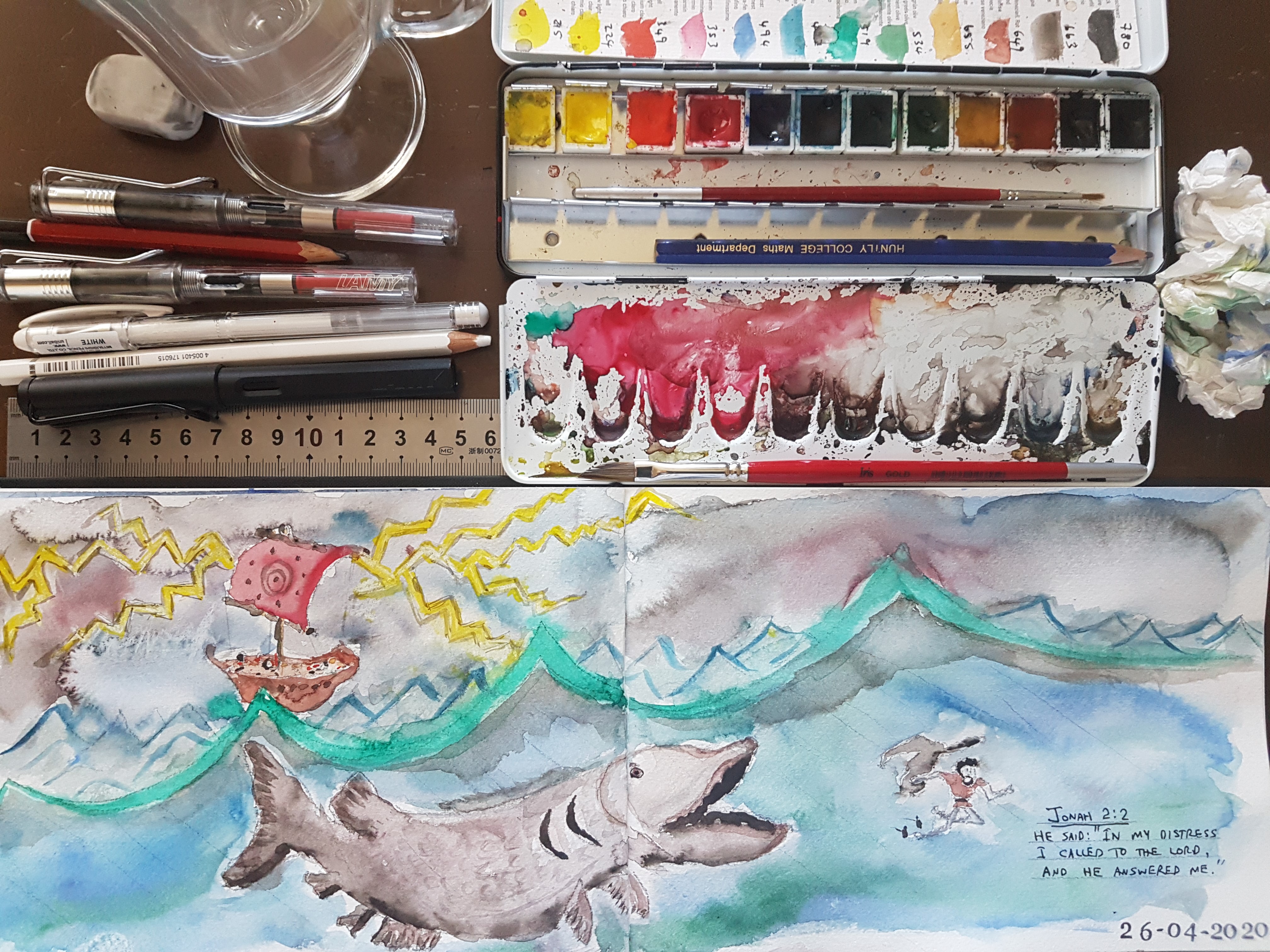
More

More lessons, e-books, and articles: https://fivehousepublishing.com/
More about the author: http://williamvanzyl.com/